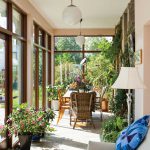Ventilation
A stove requires additional ventilation to be provided in a home. If it is rated at over 5 kW, then for every kW over that your property needs 550 m2 of open ventilation. On the other hand, any risk of carbon monoxide poisoning must be avoided as it is a real possibility in a well insulated and airtight home. The answer is for the stove to have its own dedicated air supply direct from outside.
There is an abundance of period style stoves available for traditional properties with black the most obvious choice, but there are coloured enamel and painted versions also. Contemporary styles range from long cylindrical designs to sleek inset types. Prices vary widely but a budget of €1,250/£1,000 plus installation costs of around €625/£500 is realistic. Remember to factor in the cost of lining the flue which is significant. Many wood burning stoves are also available as multifuel stoves which allow a variety of fuel such as coal or anthracite to be used. Bear in mind, though, that coal has a lot of impurities which can clog a flue up very quickly. Top of the range models can incorporate the very latest in comprehensive home heating technology.
Wood Burning Stoves
Recently, wood burning stoves have been enjoying renewed popularity. The reason for this is threefold. Oil and gas have become more expensive, stoves can give out up to five times as much heat as a regular fireplace and you do not have to rely upon utility suppliers, especially useful when there is poor weather. A stove also helps to retain heat in the home, unlike an open fire which draws air in and pulls heat up the chimney.
Stoves work mainly by radiating heat, although some offer convection panels to help distribute the heat more evenly throughout the room.
Stoves work mainly by radiating heat, although some offer convection panels to help distribute the heat more evenly throughout the room. Wood logs or pellets burn behind a glass screen which allows you to see the flames. Some models have an ‘airwash’ system to keep the glass clean, which relies on a high burn temperature for greatest effect so try not to oversize the stove. Another option is a double glazed door which achieves this but at a lower temperature.
To obtain a relaxing room temperate of around 21degC when the outside temperature is zero, a rough guide is one kW of heat for every 14 m3 of space is needed. In other words, a room measuring 7 by 4 m with a height of 2.5 m is 70 m3. Divide the space by 14 and this means the room will require a five kW stove. Other factors such as double glazing and the age of the property will influence the precise heat requirement.
Multifuel Stoves
A multifuel stove includes a grate in order to burn coal. Nearly all multifuel stoves are designed to burn wood, coal, peat and other fuels. The grate in a stove is made up of bars of metal (almost always cast iron) with gaps in between. The bars may be fixed into one rigid unit or separated to sit in a frame inside the stove. These gaps let air from below reach the coal. This also helps stop the grate bars getting too hot. The grate should be kept unblocked and any ash in the ash pan should not be allowed to come too close to the bottom of the grate or it will restrict the flow of air to the stove. Advancements in design and technology are continually improving the efficiency of multifuel stoves.
Most multifuel stoves have a riddling mechanism. Riddling works either by moving alternate grate bars up and down in a rotating motion or by allowing the whole grate to be shaken. Wood and coal should not be burned at the same time. Burning coal produces sulphuric acid and wood can contain a lot of moisture. This combination can coat the chimney in sulphuric acid which causes condensation which will leak from clay liners when not installed properly. To maintain flue gas temperatures while the stove is burning slowly, a steel sleeve and vermiculite insulation should be used. When burning coal, use a combination of both top and bottom air vents to help keep the glass from becoming blackened.
Peat remains a popular solid fuel although its production is suffering because of the wet summer weather – wet even by Irish standards! Smokeless peat briquettes are suitable for stoves and are easy to light. They have a long burn time and high heat output. Peat briquettes are made from 100% natural materials with no binders or additives. Best of all is the unmistakeable scent of burning real peat – centuries of heritage fill the air.
Other fuels such as compressed sawdust and even straw are now available from specialist stoves shops. More environmentally friendly than fossil fuels, they are easily stacked and clean to handle.
Masonry Stoves
A masonry stove is a highly efficient heat retaining fireplace constructed mostly of masonry and sometimes ceramic materials. Compressed Earth Blocks (CEBs) which are not fired can be used to build a masonry stove of the type often seen in French farmhouses. The use of CEBs allows for a more organic and flexible design suited to rural properties. Possible finishes include full thickness natural stone or stone veneer; brick; or tile and plaster. If natural stone is selected it should be solid and softer varieties like sandstone should be avoided.
Masonry stoves work according to the counter flow principle. The hot gases from the wood fire are channelled from the top to the bottom inside the stove in order to pass over a large mass of stone before exiting the chimney. The stone or earthen mass of these stoves releases a gentle radiant heat for many hours after the fire has gone out. Through high combustion temperatures of around 1,000 degC, masonry stoves are very clean and fuel efficient (85 -95%).






